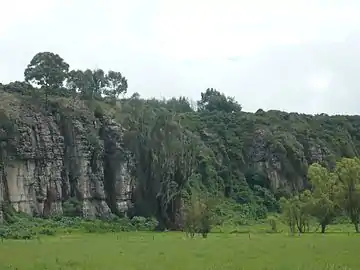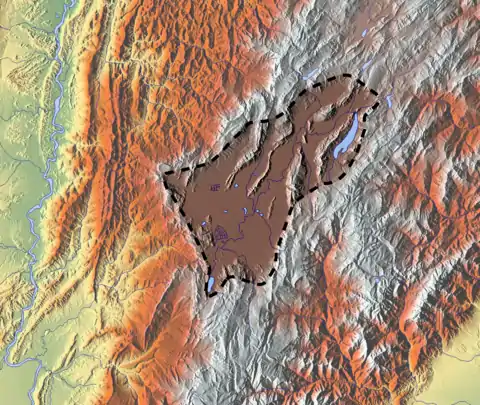El Abra
El Abra is the name given to an extensive archeological site, located in the valley of the same name. El Abra is situated in the east of the municipality Zipaquirá extending to the westernmost part of Tocancipá in the department of Cundinamarca, Colombia. The several hundred metres long series of rock shelters is in the north of the Bogotá savanna on the Altiplano Cundiboyacense, Eastern Ranges of the Colombian Andes at an altitude of 2,570 metres (8,430 ft). The rock shelter and cave system is one of the first evidences of human settlement in the Americas, dated at 12,400 ± 160 years BP. The site was used by the hunter-gatherers of the Late Pleistocene epoch.
 Petroglyph of El Abra | |
 Location within Colombia | |
| Location | Zipaquirá, Tocancipá, Cundinamarca |
|---|---|
| Region | Bogotá savanna Altiplano Cundiboyacense |
| Coordinates | 5°01′02.49″N 73°57′04.33″W |
| Altitude | 2,570 m (8,432 ft) |
| Type | Rock shelter, petroglyphs |
| Part of | Pre-Muisca sites |
| History | |
| Material | Sandstone |
| Abandoned | Herrera Period |
| Periods | Prehistory-Herrera |
| Cultures | Preceramic hunter-gatherers |
| Site notes | |
| Excavation dates | 1967 |
| Archaeologists | Correal, Hammen |
| Ownership | Hacienda El Abra, Cesar Orjuela |
| Public access | Partly |
| Designation | Climbing area |
Etymology
The name El Abra is taken from a large hacienda of that name at the foot of the western portion of the rock formation. The eastern side of the outcropping sandstones is accessible. Climbing activities at these Rocas de Sevilla are organised.[1]
Stratigraphy
The first research in the place was conducted in 1967, and the stratigraphy of lithic instruments, bones and vegetal charcoal with radiocarbon dating established the date of the settlement in 12,400 ± 160 years BP.[2][3]
Archaeological research
In the late 1960s, the Indiana University collaborated in a deeper research. In 1970, the Dutch Foundation for the Advancement of Tropical Research (NWO-WOTRO) discovered four new preceramic sites and the analysis of lacustrine sediments allowed a more accurate understanding of the paleoclimate and flora.
Fúquene stadial
The Fúquene stadial, named after Lake Fúquene, close to the village of the same name, is defined from 15,000 to 12,500 BP. It is characterized by a cold climate, flora typical of páramo ecosystems, and lithic tools.
Guantivá interstadial
About 12,500 years ago, a gradual rise of temperature allowed the return of Andean cloud forest and the settlement of many animal species, making hunting easier. Artefacts of this period are called abriense: flint (tool)s, and chopper cores. As the climate was more benign, the cave system was gradually abandoned.
Tibitó stadial
The excavations of this period, near Tocancipá at Tibitó, dated at 11,400 years BP, show lithic instruments, bone tools and remains of Pleistocene megafauna, such as mastodons (Haplomastodon waringi and Cuvieronius hyodon), American horse (Equus amerhipuus lasallei), and deer (Odocoileus virginianus) with traces of ritual ceremonies.
El Abra stadial
Dated 11,000 BP, it is characterized by a new cooling of the climate, recession of the forests and a last period of extending glaciations. From this period the archaeological site of Tequendama in Soacha shows lithic instruments (Tequendamenses tools) with a more smooth manufacture, many of them made with materials brought to this place from the Magdalena River valley, such as quartzite. At Tequendama, evidence for domestication of guinea pigs has been uncovered.
Holocene
Around 10,000 years BP, the last glaciation ended and the Andean forests appeared again. The lithic instruments show a rise in recollecting activities, with rodents and vegetables consumed, and lower amounts of large animals hunted. The El Abra caves were abandoned gradually, while other nearby rock shelters like Nemocón and open area settlements as Checua were populated.
Aguazuque
In Aguazuque, around 5,000 BP, agriculture was established on elevated terraces, grinding stone instruments can be observed in association with itinerant habits. The abriense type instruments disappear.
Tourism
While access to the western Zipaquirá part of the rock formation is restricted as it is located on private lands, the eastern area in Tocancipá is accessible and around 20 climbing routes have been constructed. The climbing is comparable but more challenging than the famous routes of Suesca, due to the overhanging character of the formation.[1]
Gallery
 Hacienda El Abra
Hacienda El Abra Rock formation of El Abra
Rock formation of El Abra Climbing at El Abra
Climbing at El Abra
See also
References
- (in Spanish) Las Rocas del Abra (Cundinamarca) climbing activities
- (in Spanish) Nivel Paleoindio. Abrigos rocosos del Tequendama Archived 2016-04-29 at Archive.today
- Gómez Mejía, 2012, p.153
Bibliography
- Gómez Mejía, Juliana. 2012. Análisis de marcadores óseos de estrés en poblaciones del Holoceno Medio y Tardío incial de la sabana de Bogotá, Colombia - Analysis of bone stress markers in populations of the Middle and Late Holocene of the Bogotá savanna, Colombia. Revista Colombiana de Antropología 48. 143-168.
Further reading
| Wikimedia Commons has media related to El Abra. |
- Aceituno Bocanegra, Francisco Javier, and Sneider Rojas Mora. 2012. Del Paleoindio al Formativo: 10.000 años para la historia de la tecnología lítica en Colombia - From the Paleoindian to the Formative Stage: 10,000 years for the history of lithic technology in Colombia. Boletín de Antropología 28. 124-156. Accessed 2016-07-08.
- Correal Urrego, Gonzalo. 1990. Aguazuque: Evidence of hunter-gatherers and growers on the high plains of the Eastern Ranges, 1-316. Banco de la República: Fundación de Investigaciones Arqueológicas Nacionales. Accessed 2016-07-08.
- Correal Urrego, Gonzalo. 1990. Evidencias culturales durante el Pleistocene y Holoceno de Colombia - Cultural evidences during the Pleistocene and Holocene of Colombia. Revista de Arqueología Americana 1. 69–89. Accessed 2016-07-08.
- Correal Urrego, Gonzalo. 1980. Estado actual de las investigaciones sobre la etapa lítica en Colombia. Antropológicas 2. 11-30.
- Correal Urrego, Gonzalo; Thomas van der Hammen, and J.C. Lerman. 1970. Artefactos líticos de abrigos en El Abra, Colombia. Revista Colombiana de Antropología 14. 9-46.
- Groot de Mahecha, Ana María. 1992. Checua: Una secuencia cultural entre 8500 y 3000 años antes del presente - Checua: a cultural sequence between 8500 and 3000 years before present, 1-95. Banco de la República. Accessed 2016-07-08.
- Hurt, Wesley; Thomas van der Hammen, and Gonzalo Correal Urrego. 1976. La ecología y tecnología de los abrigos rocosos en El Abra, Sabana de Bogotá, Colombia. Boletín de la Sociedad Geográfica Colombiana 109. 1-21.
- Hammen, Thomas van der, and E González. 1963. Historia de clima y vegetación del Pleistoceno superior y Holoceno de la Sabana de Bogotá. Boletín Geológico 1-3. 189-266.
- Hammen, Thomas van der, and Gonzalo Correal Urrego. 1978. Prehistoric man on the Sabana de Bogota: data for an ecological prehistory. Palaeogeography, Palaeoclimatology, Palaeoecology 25. 179-190.
- Hammen, Thomas van der. 1994. Stratigraphic Dating and Cultural Sequences of Pre-Hispanic Northern South America, 381-393. The Getty Conservation Institute. Accessed 2016-07-08.
- Hammen, Thomas van der. 1992. El hombre prehistórico en la Sabana de Bogotá: datos para una prehistoria ecológica. Historia, Ecología y Vegetación _. 217-231.


